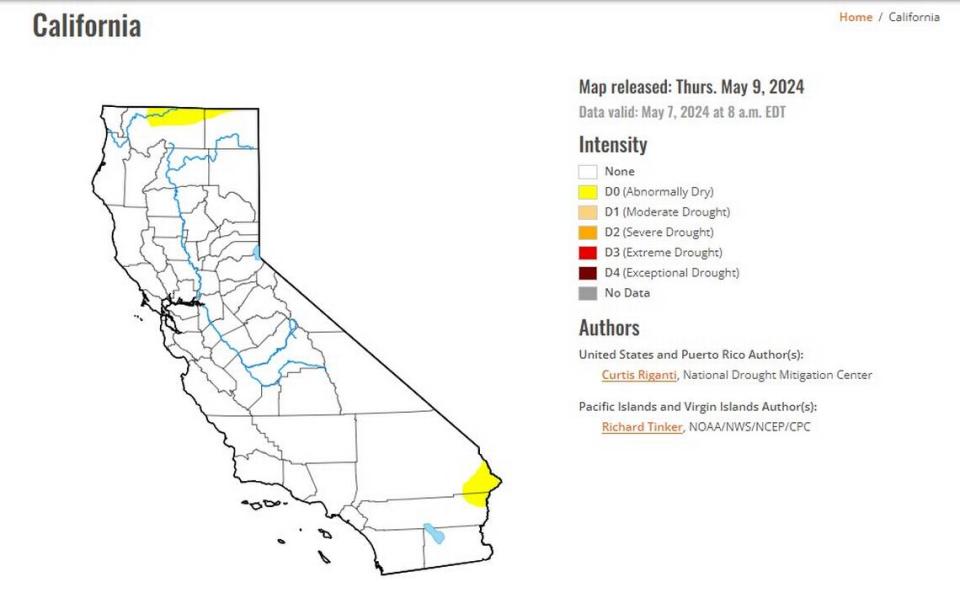California’s second-largest reservoir is full — again. How high is the water at others?
This week, California’s second-largest reservoir reached full capacity, guaranteeing a stable water supply across the state.
Lake Oroville in Butte County is filled to the brim, according to the California Department of Water Resources.
Its capacity is 3,537,577 acre-feet, sitting at 128% of its average for early May, according to reservoir data from the state water department, last updated at midnight on Wednesday.
One month prior, the reservoir was measured at 89% capacity.
“This is great news for ensuring adequate water supply for millions of Californians (and) environmental needs (and) we continue to manage both while maintaining flood protection for downstream communities,” the state water department wrote Monday in a post on X, formerly Twitter.
We are at full capacity at #LakeOroville for the 2nd year in a row! This is great news for ensuring adequate water supply for millions of Californians & environmental needs & we continue to manage both while maintaining flood protection for downstream communities. pic.twitter.com/cpOgV7RrLl
— CA - DWR (@CA_DWR) May 6, 2024
Lake Oroville, nestled behind the tallest dam in the U.S., delivers water to roughly 27 million Californians.
It also provides flood protection and aids in the state’s environmental needs.
At full capacity, wind over Lake Oroville could produce waves that crash over the crest of the emergency spillway — a normal and expected function of the design. The city of Oroville and other nearby communities are protected from flooding by controlled releases during the winter and early spring, according to the department.
California reservoir levels
California’s largest reservoir, Shasta Lake, exited early May at 96% capacity.
Much smaller Lake Casitas in Ventura County and Cachuma Lake in Santa Barbara are at or above capacity.
Most of the state’s 17 major reservoirs edged closer to their capacity levels over the past month, except Lake Sonoma in Sonoma County, San Luis Reservoir in Merced County and Diamond Valley Lake in Riverside County.
Here’s the status of the state’s major reservoirs as of Wednesday, according to data from the state water department:
Shasta Lake - Shasta County
Percent of historic average: 115%
Percent of total capacity: 96%
Lake Oroville - Butte County
Percent of historic average: 128% Percent of total capacity: 100%
Trinity Lake - Trinity County
Percent of historic average: 108% Percent of total capacity: 85%
Lake Sonoma - Sonoma County
Percent of historic average: 111%
Percent of total capacity: 69%
San Luis Reservoir - Merced County
Percent of historic average: 85%
Percent of total capacity: 67%
Cachuma Lake - Santa Barbara County
Percent of historic average: 133%
Percent of total capacity: 102%
Lake Casitas - Ventura County
Percent of historic average: 121%
Percent of total capacity: 100%
Castaic Lake - Los Angeles County
Percent of historic average: 97%
Percent of total capacity: 84%
Diamond Valley Lake - Riverside County
Percent of historic average: 119%
Percent of total capacity: 90%
New Bullards Bar Reservoir - Yuba County
Percent of historic average: 113% Percent of total capacity: 97%
Folsom Lake - Sacramento, El Dorado and Placer counties
Percent of historic average: 118% Percent of total capacity: 90%
Camanche Reservoir - Amador, Calaveras and San Joaquin counties
Percent of historic average: 140% Percent of total capacity: 92%
New Melones Lake - Calaveras and Tuolumne counties
Percent of historic average: 138% Percent of total capacity: 86%
Don Pedro Reservoir - Tuolumne County
Percent of historic average: 114% Percent of total capacity: 88%
Lake McClure - Mariposa County
Percent of historic average: 147% Percent of total capacity: 89%
Pine Flat Reservoir - Fresno County
Percent of historic average: 151% Percent of total capacity: 94%
Millerton Lake - Fresno and Madera counties
Percent of historic average: 134% Percent of total capacity: 98%
California’s drought status
According to a Thursday update from the U.S. Drought Monitor, California is completely drought-free.
The weekly drought map shows drought intensities across the U.S. Roughly 2.7% of the Golden State is “abnormally dry.”
The list includes San Bernardino, Riverside, Modoc and Siskiyou counties.

No one has lived in drought conditions since November, a significant decrease from roughly 3,000 people in October and about 9,800 people in September.
Approximately 903,000 people remained in drought areas in August.
The state has been without “moderate,” “severe,” “extreme” and “exceptional” drought conditions since October.
What do you want to know about life in Sacramento? Ask our service journalism team your top-of-mind questions in the module below or email servicejournalists@sacbee.com.

